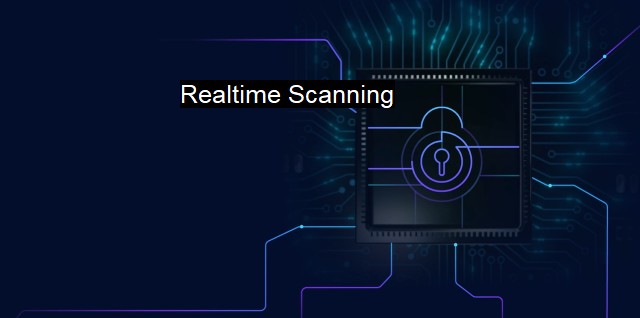What is Realtime Scanning?
The Vital Role of Realtime Scanning in Antivirus Software for Comprehensive Cybersecurity Protection
Realtime Scanning, also known as on-access scanning, is a crucial feature in cybersecurity protection software, particularly in antivirus software. This key feature actively scans a computer system's content, intending to monitor and inspect all actions executed by a user or a system's operation for any potential threats. Compared to traditional scanning techniques, Realtime Scanning has a more proactive and preventative approach to system protection, enabling actions to be verified before execution rather than dealing with threats retrospectively.To understand the function of Realtime Scanning, it is important to consider the way antivirus software traditionally functions. Generally, a user initiacyea command or clicks a link, which leads to one or several files opening. Traditional antivirus software would, at various intervals, inspect these files for any known, potentially harmful content. In contrast, Realtime Scanning offers a more proactive model wherein each action initiated triggers immediate inspection of involved documents. This inspection occurs before the initiated action has a chance to execute and therefore blocks potential threats before they have had an opportunity to cause damage.
Realtime Scanning intercepts and scans the digital DNA of documents, images, applications, and other system-integrated files. Preserving an unwavering vigil on the system, the feature predates traditional scanning by inspecting Web content in real-time while you browse the Internet. If it encounters malicious content, it immediately blocks it to prevent contamination. it promptly scans incoming and outgoing emails and their attachments, securing protected systems from email-transmitted malware threats.
The inspection methodology that underpins Realtime Scanning relies on heuristic analysis and signature-based detection, the two most effective strategies in threat identification. Heuristic analysis or heuristic-based detection examines the behavioral patterns of a file or a program. If it arouses suspicion, the heuristic algorithm either blocks it or alerts the user about the potential risk involved before executing the action. Simultaneously, signature-based detection identifies threats by comparing the file with a database of known virus signatures.
One of the most significant benefits of Realtime Scanning is the high level of ongoing security. By continuously scanning and monitoring system activities, it quickly detects and responds to potential threats, often mitigating harm and damage. This form of protection is essential due to the relentless persistence of cyber-attackers who continually discover and exploit new vulnerabilities in systems and networks.
Yet, Realtime Scanning is not without criticism. Some people argue that it causes system slowdown due to continuous scanning, and its proactive preventative model may occasionally identify legitimate files and activities as threats, a mistake known as a false positive. Each identified threat requires immediate attention, which in the case of a false positive, may translate to wasted resources and blown deadlines. To avoid such negative impacts, many cybersecurity companies have incorporated artificial intelligence and machine learning processes into Realtime Scanning to improve threat detection accuracy and minimize case number of false positives.
Realtime Scanning is an essential component of a robust cybersecurity and antivirus protection strategy. It plays a crucial role in maintaining computer device safety, data security and privacy against the endless tide of online risks. Despite facing some criticism of false positives and system lag due to its unyielding watch, Realtime Scanning's continual inspection and preventive security model make it crucial for maintaining a high level of cybersecurity grown increasingly dangerous by ongoing threats from cybercriminals. Accordingly, many cybersecurity companies are investing heavily in developing sophisticated Realtime Scanning solutions, fortifying the strength and integrity of antivirus software.

Realtime Scanning FAQs
What is realtime scanning?
Realtime scanning is a cybersecurity technique that constantly monitors a computer system or network for any malicious activity or threats. It functions as a real-time defense against viruses, malware, and other cyber threats.How does realtime scanning work?
Realtime scanning uses a combination of virus definition databases, behavioral analysis, and heuristics to detect and prevent malware from executing on a computer system or network. This technique scans files and incoming network traffic and compares them against a database of known threats to identify and block malicious activity in real-time.Why is realtime scanning important?
Realtime scanning is important because it provides quick and effective protection against malware and other cyber threats. Without it, computer systems are vulnerable to cyber attacks, which can result in data loss, system downtime, and financial losses. Realtime scanning helps to secure systems and prevent infections before they can cause serious harm.What types of threats can realtime scanning protect against?
Realtime scanning can protect against a wide variety of threats, including viruses, worms, Trojans, spyware, adware, rootkits, ransomware, and other types of malware. It can also detect and prevent phishing attacks, network-based attacks, and other types of cyber threats that could compromise the security of a computer system or network.| | A | | | B | | | C | | | D | | | E | | | F | | | G | | | H | | | I | | | J | | | K | | | L | | | M | |
| | N | | | O | | | P | | | Q | | | R | | | S | | | T | | | U | | | V | | | W | | | X | | | Y | | | Z | |
| | 1 | | | 2 | | | 3 | | | 4 | | | 7 | | | 8 | | |||||||